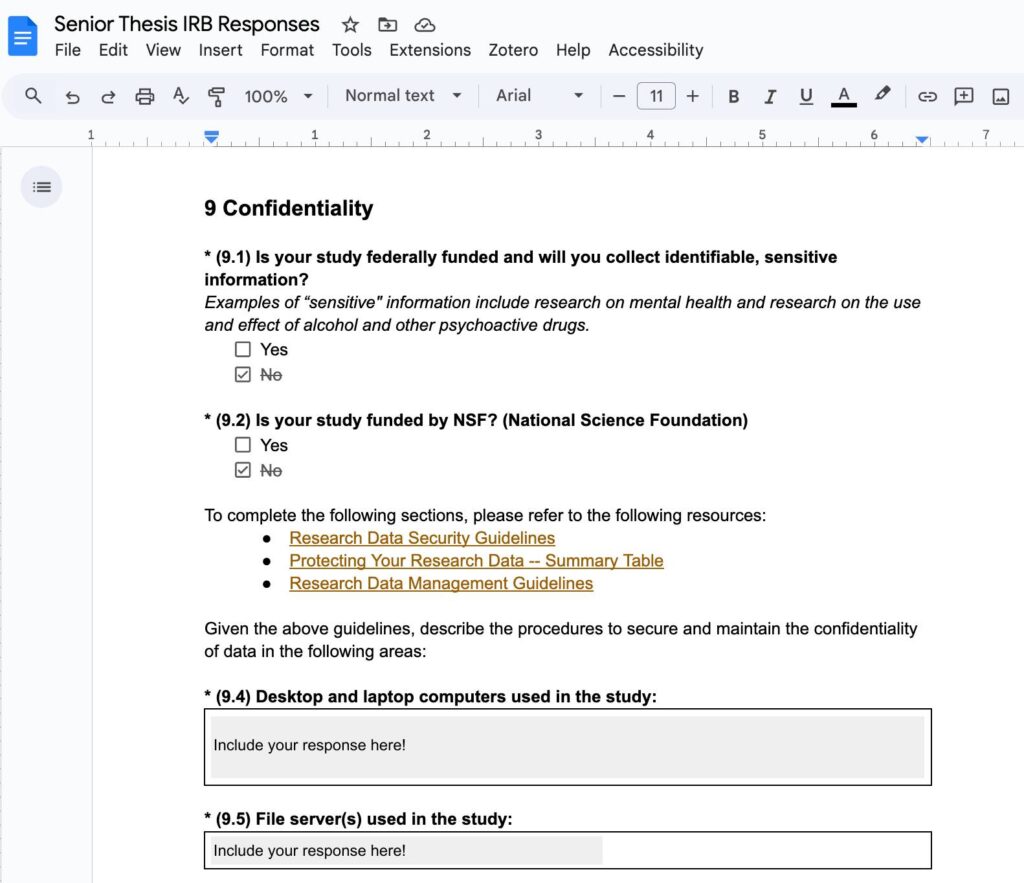
Independent research at Princeton offers an incredible opportunity for students to explore their academic interests and gain experience in the research world. This year, I’m working on my Senior Thesis with Professor Aleksandra Korolova, conducting an audit of Google ad delivery optimization algorithms. Specifically, I am studying whether aspects of advertisements—the image, text, links, and so on—impact the demographics of the audience to whom the advertisement is delivered.
In the fall, many people were curious about how my thesis was progressing. The truth was, for a few weeks, I hadn’t started running any experiments, since I first needed my research to be approved by the Institutional Review Board (IRB). Through this experience, I both gained insight into the IRB process and found that many students had never even heard of the IRB. In this article, I share my experience and offer advice for students who are planning to conduct independent research.
As explained per the Office of Undergraduate Research’s website, the mission of the IRB is “to protect the rights, privacy, and welfare of human participants in research conducted by Princeton University faculty, staff, and students.” The IRB helps ensure that research involving human participants is conducted ethically and in compliance with federal regulations—here, ethical considerations often include issues like informed consent, minimizing harm, and ensuring fairness in how participants are selected and treated. This is important because research has real-world consequences, and without proper safeguards, studies could (unintentionally) exploit, harm, or misrepresent participants. To ensure responsible research practices, the IRB reviews study designs to assess the potential risks to participants and ensure appropriate measures are in place to protect their confidentiality, safety, and well-being. And no matter what your major—whether it’s computer science, biology, sociology, or any other field—if your research involves human subjects, you’ll need to go through the IRB process!
- Completing CITI Training
Before you can submit your IRB application, you must complete Collaborative Institutional Training Initiative (CITI) training. The online course provides essential information on the ethical considerations and regulations surrounding research involving human participants, and it’s an excellent introduction to the risks and concerns you’ll need to consider as a human-subjects researcher. The training is mandatory for all researchers, and is designed to ensure that you understand the importance of protecting participants’ rights and privacy.
To complete the training, you’ll need to create a CITI account, complete the required modules, and pass the quizzes. Note that there are two available courses: one for “Social & Behavioral Research Investigators” and another for “Biomedical Research Investigators”—make sure you take the one relevant to your research. From my experience, the Social & Behavioral Research Investigators training is quite long, and it was easier for me to take brief notes on every module in preparation for the per-module quizzes. Once completed, you’ll receive a certificate that you can submit with any future IRB applications!
- Create an IRB application online.
Your application will be submitted as a form through the eRIA-IRB website. Though the user interface may not be the most intuitive, the process of creating an IRB application is quite straightforward. If you click “IRB Protocol” on the left-hand side bar and then click “Create New Protocol,” the IRB application will open in a popup window.
Since there are fifteen pages, I recommend copying each page into a Google Doc. This will allow you to easily navigate through the application and share it with adviser, PI, or any other collaborators in your lab. Using this method, it was easy for my adviser to go into my Google Doc and leave comments during and outside of our meetings.

- Filling out the IRB application.
PCUR alum Taylor Griffith has a fantastic post with tips on the IRB application, particularly with advice on research personnel, study design, confidentiality, and supporting documents. Admittedly, filling out the IRB application is not always the most straightforward process, so I would highly recommend spending time during your meetings with your adviser or lab to go over any questions you may have.
For the supporting documents section, in addition to potentially attaching consent forms, interview guides, and survey questionnaires, I have used this section to include materials such as social media messages and email templates for recruiting participants, as well as images and text shown to participants during my studies.
Since you can’t begin any experiments until you’ve received IRB approval, it’s important to start your IRB application early in the semester. However, this urgency needs to be balanced with the time required to carefully consider the details of your experiments. My responses to the study design questions underwent several iterations and discussions with my adviser, but in the end, I gained a much deeper understanding of my research questions, experiments, and the data I needed to collect—something that is not always clear at the outset of open-ended projects like senior theses!
- Revisions & Researcher Modifications
The IRB will often return your initial application with requested revisions. From my experience, they clearly specify which sections need to be revised and outline what questions you should address through your revision, along with a deadline for resubmission. When submitting your revisions, you should also include a cover letter summarizing the changes you’ve made. When I need to submit revisions, I create a concise cover letter that describes which sections I edited to address the IRB’s questions and attach it in the “Supporting Documents” section of my resubmission. I have found the IRB’s detailed instructions on how to submit your revisions through the eRIA platform to be extremely helpful!
My most important advice is to start your IRB application early and be patient throughout the process. If you haven’t heard from the IRB after a few weeks of submitting your application, you can reach out to them at irb@princeton.edu and ask for an estimated timeline on when you can expect a response.
Once you receive approval from the IRB, take a moment to celebrate this milestone! It’s an important step in your research journey, and with approval in hand, you can move forward with confidence. You’re now ready to start running your experiments and dive into the exciting work ahead. While your project may just be starting, the experience and knowledge you gain will be invaluable!
— Alexis Wu, Engineering Correspondent

